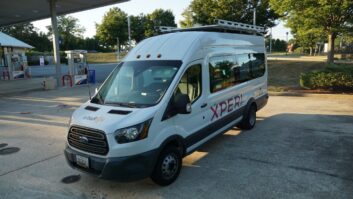Dave Garner is vice president/director of engineering for Hubbard Radio. We reached out to learn more about the broadcaster’s plans to experiment with all-digital AM radio in Maryland.
According to Hubbard, WWFD(AM) “The Gamut” has broadcast music in the Washington, northern Virginia and Frederick region since December 2011. As of mid-day Monday, “The Gamut” can be heard on 103.5 HD3 in the metro area; 107.7 HD3 in Manassas, Va.; and 103.9 HD3 in Frederick, Md.; as well as on 820 AM and 94.3 FM.
Radio: What brand of transmitter and exciter/exporter is being used?
Dave Garner: Our main is a BE AM6A and Nautel exciter/exporter. The aux transmitter is a Gates 5 with a BE ASi-10.
Radio: How good is the antenna bandwidth? Did you have to add any special networks or do any broadbanding to run optimized all-digital?
Garner: Kintronics Laboratories redesigned the phasor and tuning networks so that broader bandwidth was achieved while maintaining our licensed parameters. Dave Kolesar (Hubbard) and Mike Raide (Xperi) implemented the redesign. The retuned array can pass the MA1 hybrid HD mode (which is harder, as it requires more bandwidth than the MA3 all-digital mode).
Radio: Is this station a directional array?
Garner: 4.3 kW non directional day, and 0.430 kW night two-tower array.
Radio: Are the tests going to be done for both day and night modes; what hours?
Garner: Yes, 24/7.
Radio: Describe the routes being used to measure the signal coverage and performance.
Garner: We will start with the major interstate highways going out of Frederick, Md., (i.e. I-70 and I-270) to measure distance coverage. We will concentrate on the smaller roads and urban cores in the area, to see how well all-digital performs around buildings and electrical interference.
Radio: Are you using stock HD Radio receivers for the mobile measurements? And is the test set up and equipment similar to that used for the KRKO/KXA tests in Everett, Wash., run about five years ago?
Garner: Yes, stock car and home HD Radios will be used for testing. We will work with NAB Pilot and Xperi to test the quality of our transmissions, and so we may utilize more sophisticated equipment as well.
Radio: What results, if indeed there are any, could convince this group it would be a good idea to try all-digital operation?
Garner: I think the best test would be for someone to hear the signal, and let it speak for itself. It’s tough to convince an average listener to try a music station on analog AM, but this changes everything.
Radio: Does Hubbard have any long term plans to convert any of their stations to digital operation? Does the company see a working business model that is all-digital, and if yes, what time frame do they estimate would be required before they considered all-digital operation?
Garner: As a group, Hubbard Radio has 10 AM radio stations ranging from class A to Class D. The future business plan and timing of conversion to all digital is hard to predict, but will in many ways depend on the success of these initial on air tests from WWFD(AM).
Radio: Do you have any numbers related to the estimated cost of conversion for one station to convert to all-digital? Is the test station already running HD or is it currently analog-only?
Garner: The cost of conversion to all digital depends on many factors (transmitter age/antenna system bandwidth/infrastructure of transmission components/etc). Other than transmission hardware costs, there is usually a lot of antenna engineering consulting work needed to bring the antenna system into wideband compliance for all-digital service, and this is where a lot of the expense would be consumed.
Radio: What kind of format would be of interest for an all-digital station on AM (rather strongly occupied by talk formats, most delivered by satellite)?
Garner: With all-digital operation music along with talk would be viable formats for AM. You’re not fighting noise from interference in the final audio product — either the radio will receive it or it won’t. You could even do a classical format. WWFD is programing AAA music with breakaways for sports and will be throughout the tests.
Radio: Are you testing any kind of metadata transmission in all-digital, which presumably would have enough data bandwidth to pass along minimal program identification (comparable to RDS)? All other radio/satellite formats support this and AM is uniquely weak in this area.
Garner: Yes, metadata along with Artist Experience will be part of the all-digital tests. Other data services are possible as well, which could lead to additional revenue opportunities for AM stations.
Radio: Have there been any conversations with the FCC Audio Division about applying for an STA beyond the testing period?
Garner: We just received our Engineering Experimental Authorization for one year, so we have not had those conversations as of yet. We would like to stay digital, and so we will likely pursue either a renewal or explore a rulemaking process to have MA3 (all-digital) become a licensed mode of operation for AM broadcasters.












